[Chapter 3] Section 1 Equipment for fall prevention
1 Outline of reinforced measures to prevent falls from scaffolding since June 2009
(1) When the width between the centers of scaffold erection points is 60 cm or more, the following measures should be taken on the rear step side of the scaffold (opposite the frame side), except where there are obstacles to unloading or other operations.
1. For prefabricated scaffolding, install baseboards (*) at least 15 cm high in place of the lower part of the scaffold.
*Baseboards should be as large as possible.
2. For scaffolding other than prefabricated scaffolding, install baseboards, etc. in addition to handrails and middle rails.
(2) For prefabricated scaffolding, install a railing or a handrail on the rear step side of the scaffold, except where these may interfere with unloading or other operations.
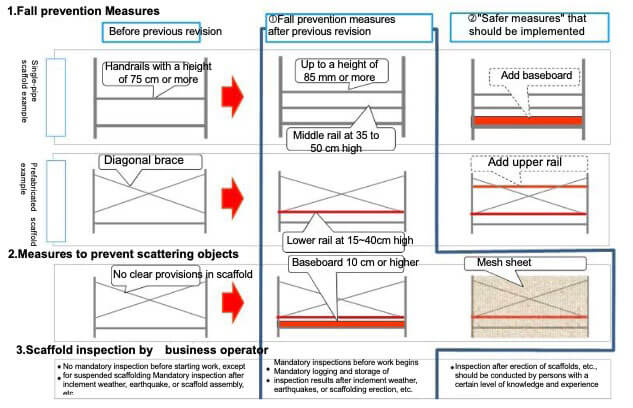
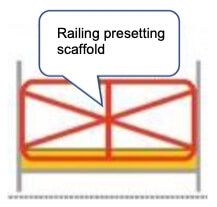
Installing preset stationary handrail based on “safer measures”
*Some types require bracing
(3) Provide a work floor that eliminates gaps between building sites in consideration of “safer measures”.
Utilize baseboards with floors, etc.
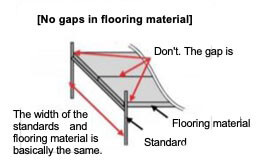
2 Installation of safety nets (protective netting)
(1) Fall prevention from pitched roofs and scaffolding
When working on a roof where there is a large distance between the eaves and the handrail, to prevent falling from a pitched roof, install a safety net for the eaves to prevent falling.
(2)When working on scaffolding, if there is a wide gap between the building frame and scaffold work floor, install an interlayer curing net (protective netting) between the scaffold building frame.
(3) In the case of low-rise housing construction, safety nets (protective netting) must be attached to the beams from the first to second floors to prevent falls before erection work is performed on the second floor.
Safety nets (protective netting) should be installed under the beams on the second and third floors, under the sheathing and under the shed frames, in stairwells, and at openings in stairwells, etc.
(4)”Technical Guidelines on Safety Standards for the Structure of Nets to Prevent Hazards Caused by Falls ( Summary )” (Ministry of Health, Labour and Welfare)
This Guideline stipulates the points of attention concerning structure, etc. of nets to be used horizontally (hereafter referred to as “Net”.) in order to prevent workers from dangers due to falls at construction sites, etc.
□ Definition
(1) Mesh means numerous consecutive mesh threads.
(2) Knot means a knot of netting threads forming the apex of the netting.
(3) Edging rope means a rope forming the perimeter of the net.
(4) Tailing thread means thread used to tie the edging rope to the netting.
(5) Suspension rope means rope used to attach the net to a support point.
□ Structure, etc.
(1) The net shall have an edging rope, a tailoring line, a suspension rope, a test line, etc.
(2) The material of the net shall be synthetic fiber.
(3) The length of each side of the net shall be 10 cm or less.
(4) The mesh shall be made of folds or other knots that will not shift.
(5) After passing through the surrounding mesh, the rope shall be tied to the netting thread with a tailoring thread so that it does not shift.
(6) The connection between the rope and the suspension rope shall be made by tying the rope to the suspension rope by satsuma braiding three or more times or by a method that is at least as secure as this method.
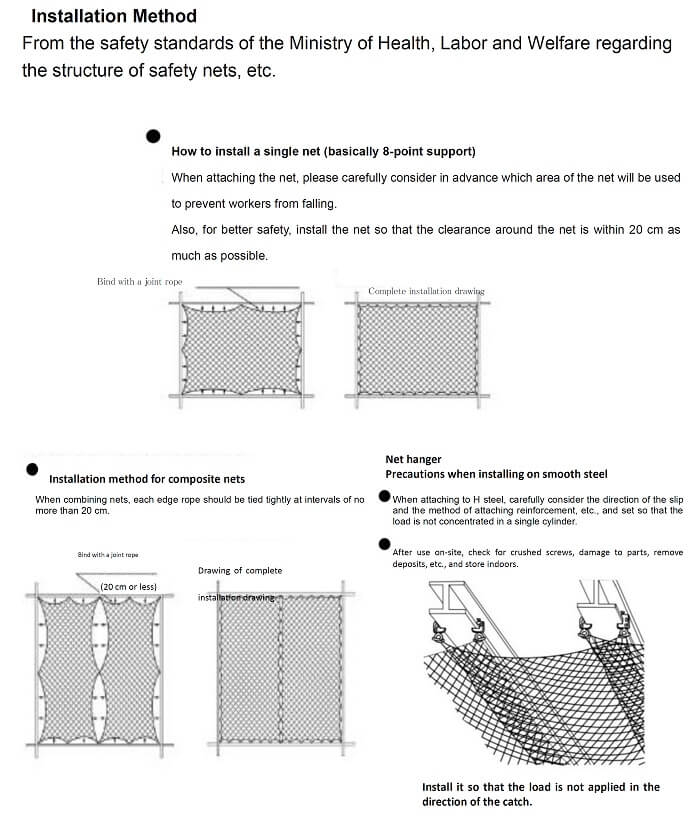
3 Measures to prevent hazards from falling objects
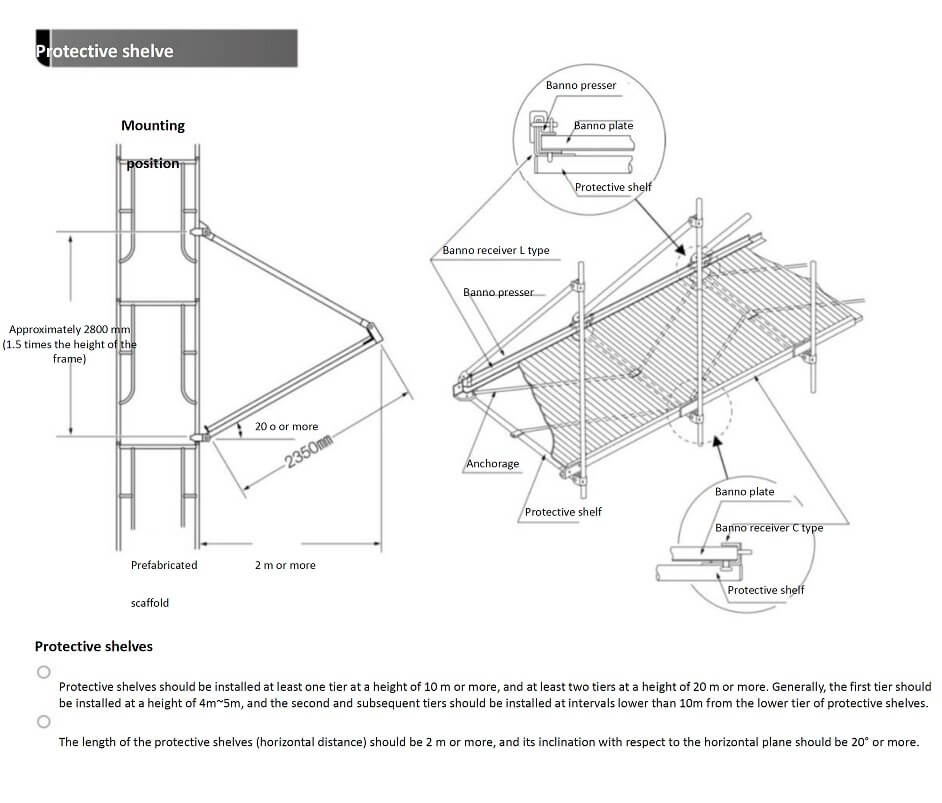
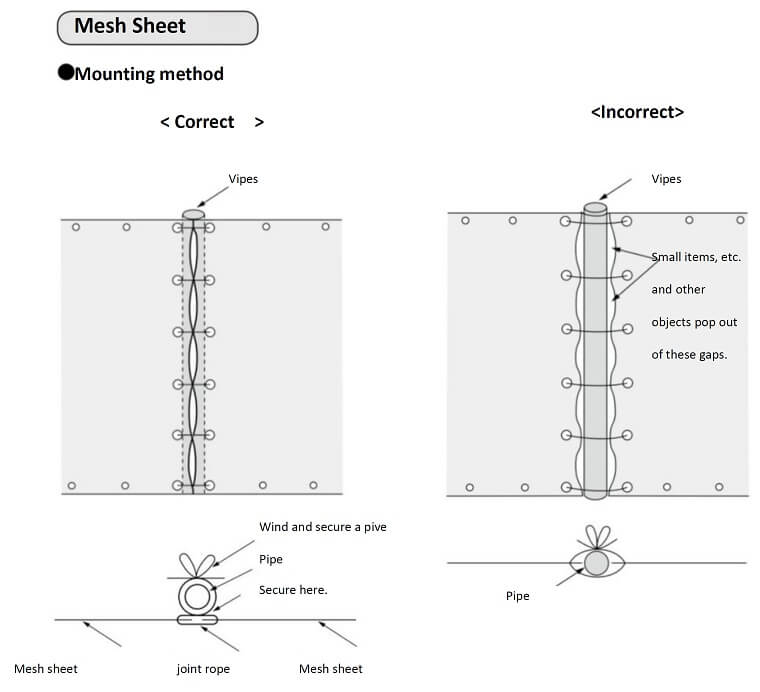
From Scaffolding and Construction Equipment Association of Japan Standards of Use
(1)When using the mesh sheet, take measures such as inspection and replacement according to 1. to 5. below.
1.If the product has been used for more than one month, perform a periodic inspection of the attached state of the tensioning part within one month every month.
2.After heavy rain, strong wind, etc., carry out a temporary inspection for abnormalities of the mesh sheets, horizontal supports, etc.
3.When performing welding work in the vicinity of mesh sheets, check the mesh sheets immediately after the completion of the welding work for damages caused by welding sparks or fusing pieces. If there is damage, replace or repair with a normal one.
4.If a part of the mesh sheet has been removed in order to transfer materials, etc., and it can be replaced back, make sure it has been restored to its original state.
5.If the mesh sheet or support material is damaged due to collision with scattering or falling objects or equipment under construction, replace with a normal one or repair.
(2)When using the mesh sheet, do not use the following for protection against scattering and falling objects.
1.Mesh sheets with damaged mesh or mesh teeth.
2.Those without quality labeling.
3.Those without a flameproof label
(3) Mesh sheets should not be used as safety nets stretched horizontally to prevent falls.
(4)When using paints containing organic solvents such as toluene that affect the strength of the synthetic resin glue, do not let the paint directly touch the synthetic resin glue.
(5)Use a binder with tensile strength of 0.98 kN or more.
(6)Use a mesh sheet that fits the dimensions of the outer and inner corners so that there are no gaps.
(7)If a typhoon or strong wind (wind velocity of 15 m/s or more) is expected, remove the mesh sheet or move it to one side and secure it properly.
Article 136 -5 of the Enforcement Ordinance of the Labor Standards Law: Protection against falling objects
In construction work, etc., if the area where construction work is to be performed is within 5 m horizontally from the boundary line of the construction site and 7 m or more in height from the ground, or if there is a risk of danger to the area around the construction site from falling debris resulting from lifting, clearing, repairing exterior walls, etc., measures shall be taken to prevent danger from falling debris, by covering the area around the construction site and other areas with steel netting or canvas, etc., in accordance with the standards specified by the Minister of Land, Infrastructure, Transport and Tourism.
Outline of public disaster prevention measures for the Ministry of Land, Infrastructure, Transport and Tourism construction
If there are neighboring houses, areas used for general traffic or other purposes within a horizontal distance of 5m, install protective shelves, etc. to prevent falling objects.
1.If the height of the area where construction work is to be performed is 10 m or more above ground level, install one or more shelves; if the height of the area is 20 m or more above ground level, install two or more shelves.
2.Install the lowest protective shelf within 10 m below the construction work, etc.
3.Install protective shelves horizontally.Each protective shelf shall protrude 2 m or more horizontally, and the angle between the shelf and the horizontal plane shall be 20 degrees or more. They must be mounted firmly on the framework to prevent it from falling off due to wind pressure, vibration, shock, snow load, etc.
地域・講習・人数に合わせてすぐに予約可能
講習会を予約する受講者様のご希望に合わせ、以下のタイプの講習会もご用意しています

このページをシェアする
講習会をお探しですか?